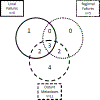Long-Term Outcomes of NRG Oncology/RTOG 0529: A Phase 2 Evaluation of Dose-Painted Intensity Modulated Radiation Therapy in Combination With 5-Fluorouracil and Mitomycin-C for the Reduction of Acute Morbidity in Anal Canal Cancer
- PMID: 34400269
- PMCID: PMC8688291
- DOI: 10.1016/j.ijrobp.2021.08.008
Long-Term Outcomes of NRG Oncology/RTOG 0529: A Phase 2 Evaluation of Dose-Painted Intensity Modulated Radiation Therapy in Combination With 5-Fluorouracil and Mitomycin-C for the Reduction of Acute Morbidity in Anal Canal Cancer
Abstract
Purpose: A multi-institutional phase 2 trial assessed long-term outcomes of dose-painted intensity modulated radiation therapy (IMRT) with 5-fluorouracil (5FU) and mitomycin-C (MMC) for anal canal cancer.
Methods and materials: T2-4N0-3M0 anal cancers received 5FU (1000 mg/m2/d, 96-hour infusion) and MMC (10 mg/m2 bolus) on days 1 and 29 of dose-painted IMRT prescribed as follows: T2N0 = 42 Gy elective nodal and 50.4 Gy anal tumor planning target volumes, 28 fractions; T3-4N0-3 = 45Gy elective nodal, 50.4 Gy ≤3 cm and 54 Gy >3cm metastatic nodal and 54 Gy anal tumor planning target volumes, 30 fractions. Local-regional failures, distant metastases, and colostomy failures were assessed using the cumulative incidence method, and disease-free survival, overall survival, and colostomy-free survival were assessed using the Kaplan-Meier method. Late effects were scored using National Cancer Institute-Common Terminology Criteria for Adverse Events v3.
Results: Of 52 patients, 54% were stage II, 25% were stage IIIA, and 21% were stage IIIB. Median follow-up was 7.9 years (min-max, 0.02-9.2 years). Local-regional failure, colostomy failures, distant metastases, overall survival, disease-free survival, and colostomy-free survival at 5 years are 16% (95% confidence interval [CI], 7%-27%), 10% (95% CI, 4%-20%), 16% (95% CI, 7%-27%), 76% (95% CI, 61%-86%), 70% (95% CI, 56%-81%), and 74% (95% CI, 59%-84%); and at 8 years they are 16% (95% CI, 7%-27%), 12% (95% CI, 5%-23%), 22% (95% CI, 12%-34%), 68% (95% CI, 53%-79%), 62% (95% CI, 47%-74%) and 66% (95% CI, 51%-77%), respectively. Eight patients experienced local-regional failure, with 5 patients having persistent disease at 12 weeks. No isolated nodal failures occurred in the microscopic elective nodal volumes. Six patients required colostomy-5 for local-regional salvage and 1 for a temporary ostomy for anorectal dysfunction. Rates of late adverse events included: 28 patients (55%) with grade 2, 8 patients (16%) with grade 3, 0 patients with grade 4, and 2 patients (4%) with grade 5 events (sinus bradycardia and myelodysplasia, possibly owing to chemotherapy). Only 11 patients reported grade 1 to 3 sexual dysfunction.
Conclusions: Dose-painted IMRT with 5FU/MMC for the treatment of anal canal cancer yields comparable long-term efficacy as conventional radiation cohorts. Enhanced normal tissue protection lowered rates of grade 3 and higher late effects without compromising pelvic tumor control.
Copyright © 2021 Elsevier Inc. All rights reserved.
Figures




References
-
- Nigro ND, Vaitkevicius VK, Considine B Jr., et al. Combined therapy for cancer of the anal canal: a preliminary report. Dis Colon Rectum 1974;17:354–356. - PubMed
-
- Epidermoid anal cancer: results from the UKCCCR randomised trial of radiotherapy alone versus radiotherapy, 5-fluorouracil, and mitomycin. UKCCCR Anal Cancer Trial Working Party. UK Co-ordinating Committee on Cancer Research. Lancet 1996;348:1049–1054. - PubMed
-
- Bartelink H, Roelofsen F, Eschwege F, et al. Concomitant radiotherapy and chemotherapy is superior to radiotherapy alone in the treatment of locally advanced anal cancer: results of a phase III randomized trial of the European Organization for Research and Treatment of Cancer Radiotherapy and Gastrointestinal Cooperative Groups. J Clin Oncol 1997;15:2040–2049. - PubMed
-
- Flam M, John M, Pajak TF, et al. Role of mitomycin in combination with fluorouracil and radiotherapy, and of salvage chemoradiation in the definitive nonsurgical treatment of epidermoid carcinoma of the anal canal: results of a phase III randomized intergroup study. J Clin Oncol 1996;14:2527–2539. - PubMed
-
- Ajani JA, Winter KA, Gunderson LL, et al. Fluorouracil, mitomycin, and radiotherapy vs fluorouracil, cisplatin, and radiotherapy for carcinoma of the anal canal: A randomized controlled trial. JAMA 2008;299:1914–1921. - PubMed
Publication types
MeSH terms
Substances
Grants and funding
LinkOut - more resources
Full Text Sources
Medical

